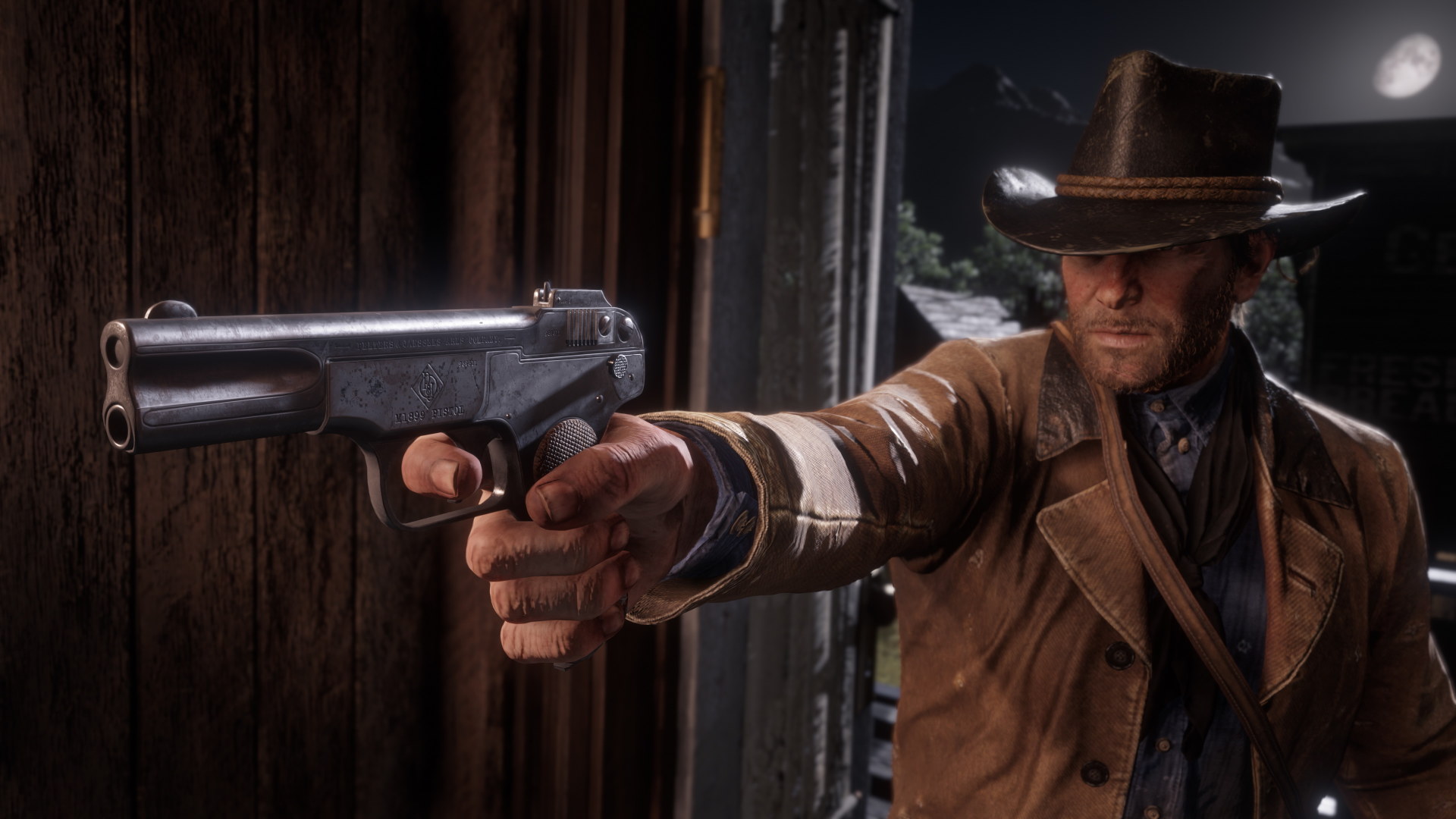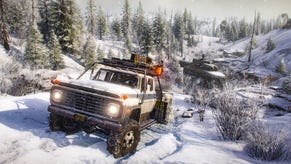Red Dead Redemption 2 PC settings guide: How to get the best performance
All aboard the rootin' tootin' frame rate machine
Red Dead Redemption 2 hasn't had the smoothest of starts on PC, but now that most of its crashing issues and unexpectedly quitting launcher problems appear to have been resolved, it's time to take a closer look at Red Dead Redemption 2's PC settings and how you can get this beaut of a game running as smoothly as possible. In this article, I've focused on what kind of performance you can expect to see from Red Dead Redemption 2's recommended PC requirements (that is, with a GTX 1060 in your system), but you can also hop over to my separate PC performance article on what you really need to get Red Dead 2 running at 60fps for a more detailed look at what other graphics cards are capable of (and surprise, you don't need an RTX 2060 like Nvidia previously suggested).
So, without further ado, here's everything you need to know about Red Dead Redemption 2's PC settings, including which of its many dozens of graphics options you can turn down to help boost your frame rate, as well as how to wrangle its 21 different quality presets (yes, you did read that correctly) into something playable.
Red Dead Redemption 2 PC requirements
Before we do that, let's remind ourselves of what Red Dead 2's PC requirements actually entail. As you can see below, both the minimum and recommended requirements are both surprisingly manageable. Nvidia's GTX 1060 remains one of the most popular and widely used graphics cards on the planet, according to Steam's hardware charts, so most PCs out there should be able get the game running.
Minimum PC requirements:
OS: Windows 7
CPU: Intel Core i5-2500K / AMD FX-6300
RAM: 8GB
GPU: Nvidia GeForce GTX 770 (2GB) / AMD Radeon R9 280 (3GB)
Storage: 150GB
Recommended PC requirements:
OS: Windows 10
CPU: Intel Core i7-4770K / AMD Ryzen 5 1500X
RAM: 12GB
GPU: Nvidia GeForce GTX 1060 (6GB) / AMD Radeon RX 480 (4GB)
Storage: 150GB
However, on the day Red Dead Redemption 2 launched on PC, Nvidia struck fear into the hearts of all and sundry by publishing their own list of recommended graphics cards for hitting that all important frame rate figure of 60fps. Naturally, the list contained nothing but Nvidia RTX cards, but the idea that you'd need at least the £350 / $380 RTX 2060 to get 60fps on High at 1920x1080 did make me question whether Rockstar's own PC requirements were entirely accurate.
Add to that several people failing to run the game on even its lowest graphics settings at 1080p on launch day and it's clear Red Dead Redemption 2 isn't quite as friendly as we might have thought.
Red Dead Redemption 2 PC settings: How to get the best performance
Luckily, I'm here to help, because boy howdy is Red Dead Redemption 2's graphics menu confusing. For starters, Rockstar have completely eschewed the standard quality presets like 'Low', 'Medium', 'High' and 'Ultra' for a sliding scale that goes from settings that 'Favour Performance' to those that 'Favour Quality'. And to make matters worse, there are 21 of them. Twenty-one! That's seven for 'Favour Performance', seven for 'Balanced', and another seven for 'Favour Quality', which is, frankly, madness.
Plus, each preset will give you completely different results based on what graphics card you have in your PC. When I turned the settings right down on my RTX 2080 Ti, for example, Texture Quality was automatically set to High, even though the rest of the graphics settings were a mix of Low and Medium. On my 6GB GTX 1060, however, the lowest preset gave me Low Texture Quality, with a mix of Low and completely turned off settings. More madness.
That's going to make Red Dead Redemption 2 incredibly hard to benchmark in the coming days, but I will do my best to bring you some (hopefully) useful advice on how to tame this beast of a game.
The good news, at least, is that even Red Dead Redemption 2's highest bunch of settings (everything cranked up to the farthest 'Favour Quality' end of the scale) only requires 3.5GB of your graphics card's memory banks at 1080p, so at least they won't be overloaded from that point of view.




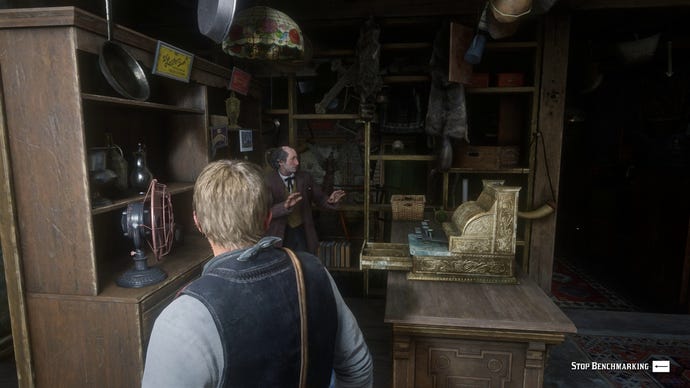
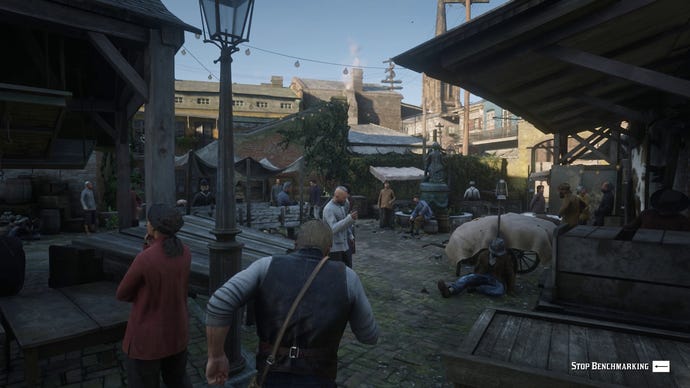
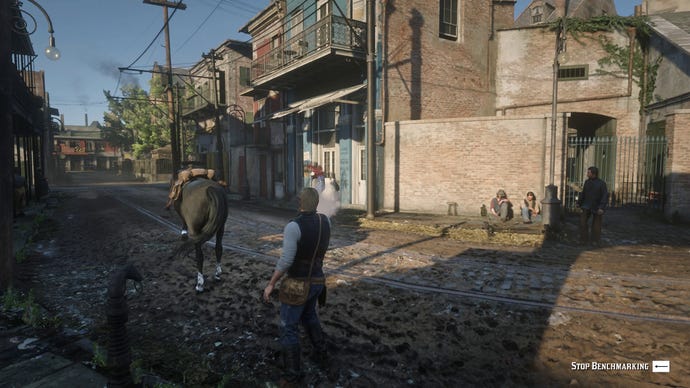





Red Dead Redemption 2's built-in benchmark uses a number of in-game scenes to test the game's performance, from snowy mountains, boggy swamps, the wild outback and a shootout (on foot and on horseback) in the busy St. Denis. This is what the game looks like on completely maxed out settings (click to enlarge).
So, seeing as how a 6GB GTX 1060 is Rockstar's recommended graphics card for Red Dead Redemption 2, let's take that as our starting point for how to get the best performance from it at 1920x1080.
At first, it wasn't looking too hopeful. Using the game's lowest possible preset in the 'Favour Performance' category, my Asus GeForce GTX 1060 card managed an average bang-on 60fps. But that's with low Texture Quality, low Lighting Quality, low shadow quality, low everything. The only Medium settings it gives me are for SSAO (screen space ambient occlusion, the stuff wot does a game's ambient shadows and soft lighting) and TAA anti-aliasing (which helps smooth out rough, jaggedy edges). It's hardly what I'd call the "recommended" graphics settings for a game of this calibre.
Thankfully, Red Dead 2's higher-end PC settings are surprisingly forgiving. Moving up to the game's so-called 'Balanced' preset, for example (which is actually the second preset in this category, because the first gives you exactly the same settings as what I've described above), this turns the Texture Quality straight up to Ultra, along with Medium Light Quality, SSAO, Water Quality, Particle Quality, Tessellation Quality and TAA again and Low everything else (see below). With these settings, my GTX 1060 managed an average of 56fps, which is a lot better than I was expecting given the large jump in Texture Quality.
The above preset is still a decent mix of Low and Medium settings, however, which may not be quite to your liking. The next Balanced preset rectifies that with a greater emphasis on Medium settings (while still keeping that Ultra-fied Texture Quality), and also introduces High Shadow Quality and x4 Anisotropic Filtering as opposed to x2. This started to take its toll on my GTX 1060, which only managed an average of 49fps with these settings, but it still looked nice and smooth in the benchmark and was more than playable in-game.
To help push that number back up a bit, turn Shadow Quality back down to Medium and turn Anisotropic Filtering back down to x2. This boosted my average frame rate up to 51fps, which isn't much, all told, but it's better than nothing.
Perhaps more surprising was what little difference the Texture Quality makes. Admittedly, this isn't wholly surprising given the tiny drop of just 4fps down from that initial 60fps, but knocking this down to High in addition to changing the Shadow Quality and AF settings made no difference to my overall frame rate whatsoever. As such, you might as well leave this as high as possible, because you're not really getting much benefit from having it lower.
Instead, you'll want to turn your attention to Red Dead Redemption 2's Advanced Graphics settings. These are locked by default and change automatically depending on what quality preset you decide to settle on, but you can easily unlock them so you can change them manually. On the largely Medium-based 'Balanced' preset, for example, there are quite a few settings that have already crept up to High or above, including Soft Shadows and TAA Sharpening. Once I'd turned the latter all the way off and Soft Shadows down to Medium (and turned off Motion Blur, which is also found here), that nudged my average frame rate up again to 53fps.
That's probably about as good as it's going to get for GTX 1060 owners, however, as trying to run the game on the next 'Balanced' preset, which mostly consists of High setting options reduced my card to an average of just 44fps. It's playable, sure, but not quite as silky smooth as you might hope.
Still, the good news is that Nvidia's claims about needing an RTX 2060 to hit 60fps on High at 1920x1080 are rather over-exaggerated. Remember, the RTX 2060 is pretty much on par with a GTX 1070 Ti in terms of overall power, but as you can see from my What you really need to get Red Dead 2 running at 60fps article, you can pretty much hit that figure with a GTX 1660 Super or above. The regular GTX 1660 and older GTX 1070 need a teensy bit of tweaking before they can hit that kind of speed, but all it takes is a couple of settings tweaks and you can enjoy largely High settings on those cards at 1080p without compromising on frame rate.


